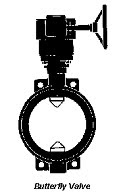Sizing flow valves is a science with many rules of thumb that few people agree on. In this article I'll try to define a more standard procedure for sizing a valve as well as helping to select the appropriate type of valve. **Please note that the correlation within this article are for turbulent flow
Key Variables: Total pressure drop, design flow, operating flow, minimum flow, pipe diameter, specific gravity
STEP #2: Define a maximum allowable pressure drop for the valve
When defining the allowable pressure drop across the valve, you should first investigate the pump. What is its maximum available head? Remember that the system pressure drop is limited by the pump. Essentially the Net Positive Suction Head Available (NPSHA) minus the Net Positive Suction Head Required (NPSHR) is the maximum available pressure drop for the valve to use and this must not be exceeded or another pump will be needed. It's important to remember the trade off, larger pressure drops increase the pumping cost (operating) and smaller pressure drops increase the valve cost because a larger valve is required (capital cost).The usual rule of thumb is that a valve should be designed to use 10-15% of the total pressure drop or 10 psi, whichever is greater. For our system, 10% of the total pressure drop is 15 psi which is what we'll use as our allowable pressure drop when the valve is wide open (the pump is our system is easily capable of the additional pressure drop).
STEP #3: Calculate the valve characteristic

For our system,

Before a valve can be selected, you have to decide what type of valve will be used (See the list of valve types later in this article). For our case, we'll assume we're using an equal percentage, globe valve (equal percentage will be explained later). The valve chart for this type of valve is shown below. This is a typical chart that will be supplied by the manufacturer (as a matter of fact, it was!)

For our case, it appears the 2 inch valve will work well for our Cv value at about 80-85% of the stroke range. Notice that we're not trying to squeeze our Cv into the 1 1/2 valve which wouldneed to be at 100% stroke to handle our maximum flow. If this valve were used, two consequences would be experienced: the pressure drop would be a little higher than 15 psi at our design (max) flow and the valve would be difficult to control at maximum flow. Also, there would be no room for error with this valve, but the valve we've chosen will allow for flow surges beyond the 150 gpm range with severe headaches!
So we've selected a valve...but are we ready to order? Not yet, there are still some characteristics to consider.
STEP #5: Check the Cv and stroke percentage at the minimum flow
If the stroke percentage falls below 10% at our minimum flow, a smaller valve may have to be used in some cases. Judgements plays role in many cases. For example, is your system more likely to operate closer to the maximum flowrates more often than the minimum flowrates? Or is it more likely to operate near the minimum flowrate for extended periods of time. It's difficult to find the perfect valve, but you should find one that operates well most of the time. Let's check the valve we've selected for our system:

STEP #6: Check the gain across applicable flowrates

we have corresponding Cv values of 6.5, 28, and 39. The corresponding stroke percentages are 35%, 73%, and 85% respectively. Now we construct the following table:
Flow (gpm) | Stroke (%) | Change in flow (gpm) | Change in Stroke (%) |
25 | 35 | 110-25 = 85 | 73-35 = 38 |
110 | 73 | ||
150 | 85 | 150-110 = 40 | 85-73 = 12 |

No comments:
Post a Comment